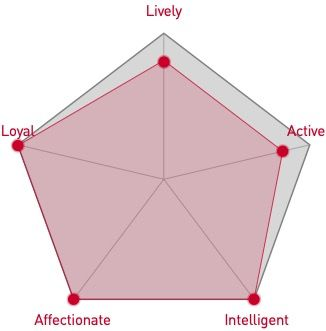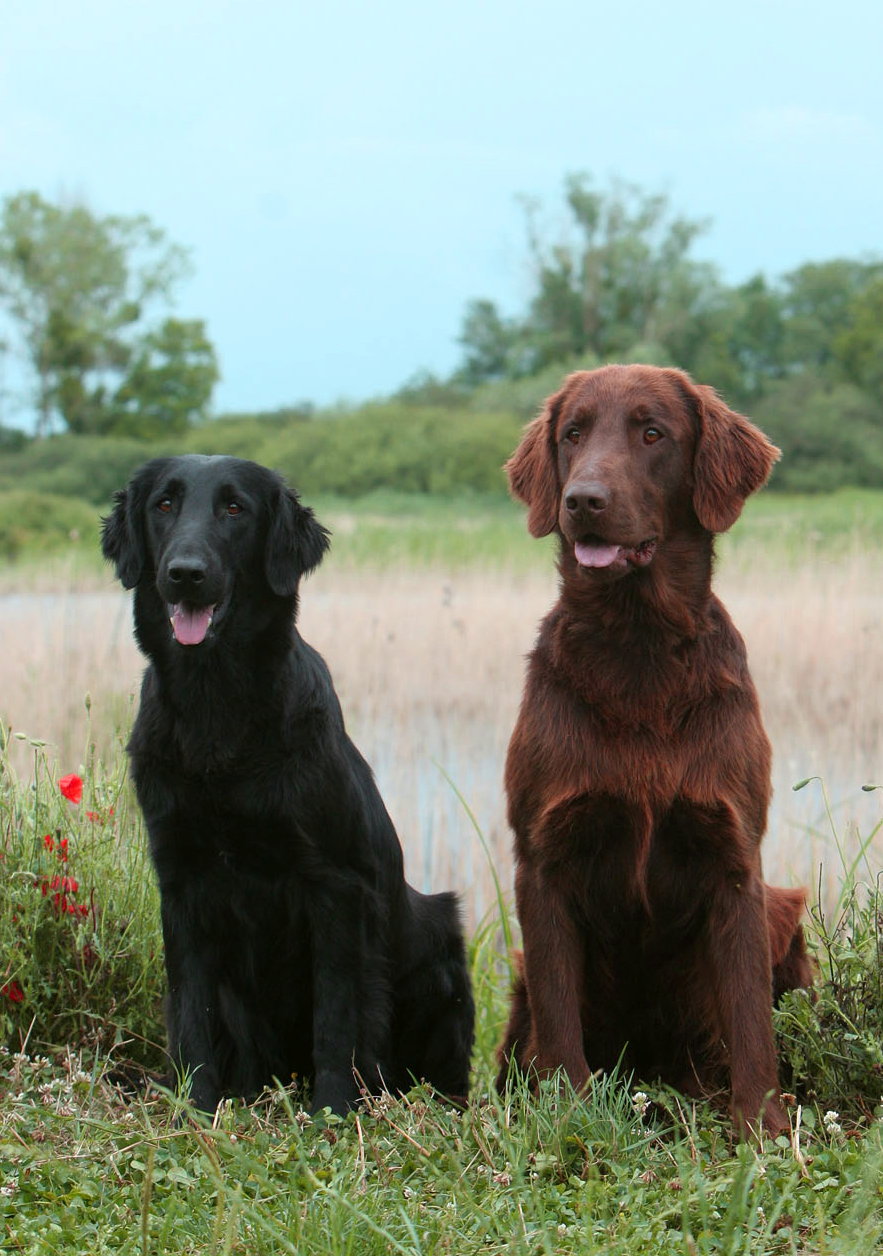
Let's talk Flat-Coated Retrievers
A flowing ebony coat may be their trademark but it’s merely the starting point for the positive attributes for the Flat-Coated Retriever. An incredibly docile nature dwells within, and a huge zest for life: The Flat-Coated Retriever is a very, very contented dog, nicknamed the “Peter Pan” of the canine world for their puppy-like conduct that lasts well into adulthood. That said, the Flat-Coated Retriever is known for usually being on their best behaviour, a plus whether this sporting dog is in the house or out.Official name: Flat-Coated Retriever
Other names: Flat-Coat, Wavy-Coated Retriever, Black Wavy Retriever, Smooth-Coated Retriever
Origins: England

| Drooling tendencies: |
|
Warm weather? |  |
| Shedding level: | Suited to apartment living? | ||
| Energy level (high, low, medium) *: | High | Family pet? * |
|
| Compatibility with other pets: | Can stay alone? * |
* We advise against leaving pets alone for long stretches. Companionship can prevent emotional distress and destructive behaviour. Speak to your veterinarian for recommendations.
Every pet is different, even within a breed; this snapshot of this breed’s specifics should be taken as an indication.
For a happy, healthy and well-behaved pet, we recommend educating and socialising your pet as well as covering their basic welfare, social and behavioural needs.
Pets should never be left unsupervised with a child.
All domestic pets are sociable and prefer company. However, they can be taught to cope with solitude from an early age. Seek the advice of your veterinarian or trainer to help you do this.


| Baby age: | Birth to 2 months |
| Puppy age: | 2 to 15 months |
| Adult age: | 15 to 5 years |
| Mature age: | 5 to 8 years |
| Senior age: | From 8 years |

1/7
Get to know the Flat-Coated Retriever
All you need to know about the breed
A regal dog with a jubilant disposition, the Flat-Coated Retriever is one of the ultimate convivial breeds. Originally bred for hunting, the breed was often seen on the 19th century estates of the English upper class, earning their keep by accompanying masters into the field and stream and excelling at what Retrievers do best: Fetching and retrieving.
That athletic ability, along with an amicable manner, has made the breed a cherished family dog and a frequent sight in the show ring, showing off the long locks that are the Flat-Coated Retriever’s standout trait. Functional as well, their signature coat protects this active dog from the icy conditions they often find themselves in.
The breed does have what can be called a mischievous side, a factor potential owners should think about when matching their activity level to a new pet. It’s because the Flat-Coated Retriever is known to mature slowly so best to have plenty of toys on hand to keep them occupied. They can also be mouthy (all that retrieving leaves its mark).
Although perhaps not as well-known as Labradors or Golden Retrievers, the Flat-Coated Retriever flourishes with all family members, especially children, once properly introduced and trained. They just may not be the best guard dog since they’re a little too welcoming of everyone they meet.

2/7
2 facts about Flat-Coated Retrievers
1. Water baby
Nothing pleases the Flat-Coated Retriever more than being in the water. Lake, ocean, river, or bathtub, they’re more than content to dive right in and splash around. And fetching something? All the better. Their breeding as a hunting dog, used to retrieve waterfowl in frozen conditions, continues to this day.
2. Chew on this
The Flat-Coated Retriever is by all measures a great dog, for both families and single people alike, but can have the propensity to chew, especially if they are bored or unoccupied. The habit can be curbed with properly training your Flat-Coated Retriever in puppyhood. Stocking your house with chew toys will ensure they put those – and not your shoes – in their mouth.
History of the breed
The origins of the Flat-Coated Retriever are said to have been on the island of Newfoundland, Canada, where fishing is a mainstay of life. Catch that would bounce out of fishermen’s nets necessitated a dog that could jump after it, while withstanding the very chilly northern waters.
The dog’s breeding then took off in Britain in the mid-19th century, using a mix of Setters, Newfoundlands, Water Spaniels, and Sheepdogs. The Flat-Coated Retriever dog was seen on the vast estates of the English gentry, earning the nickname, the “Gatekeeper’s Dog.” The breed was widely used in the hunting of waterfowl, valued for their quick retrieval and upbeat demeanour.
The Flat-Coated Retriever‘s popularity receded over time with the rise of the Labrador Retriever and Golden Retriever, but they are still highly beloved by those who know the breed. The American Kennel Club registered the breed in 1915 and the United Kennel Club in 1984.

4/7
From head to tail
Physical characteristics of Flat-Coated Retrievers
1. Ears
Thick, feathered ears, fairly small, lying close to head.
2. Body
Long, well-muscled body, strong deep chest.
3. Coat
Signature flat coat, dense with slight wave, almost exclusively black, sometimes liver-coloured.

5/7
Things to look out for
From specific breed traits to a general health overview, here are some interesting facts about your Flat-Coated Retriever

6/7
Caring for your Flat-Coated Retriever
Grooming, training and exercise tips
A dog with a “signature coat” conjures up visions of arduous grooming. Not so for the Flat-Coated Retriever, whose hair falls straight away from their body into divine waves. A weekly run-through with both a brush and a metal dog comb is sufficient to remove dead hair and dirt. An active dog like this will need regular nail trims, and a clean-out of debris from those lovely ears. Brush their teeth often to ward off tartar build-up. When it comes to exercise for your Flat-Coated Retriever, think swimming and fetching. Anything that involves either of these two activities will make your dog’s spirit sing. This is a dog that needs space to run so a country locale would suit them perfectly, but if they’re suburban dwellers, daily walks will work (at least two). As one would expect, the very jubilant Flat-Coated Retriever is easy to train, but it’s important to not apply any harsh methods as this is one breed who won’t react well. Correct your dog with ease and they will respond in kind. Consistent socialisation and puppy training classes will help form a well-behaved Flat-Coated Retriever.7/7
All about Flat-Coated Retrievers
Newfoundlands, Sheepdogs, Water Spaniels, and various types of setters were all part of the mix that created the Flat-Coated Retriever. With time, the breed came into their own, and developed a devoted following where humans were concerned. A sturdy dog who could withstand the elements yet remain chipper was the aim, and the result.
Hugely merry, easily trainable, oodles of affectionate–the Flat-Coated Retriever is a sheer delight! With a perpetually wagging tail and pleasant expression, is there a downside? Excessive jumping up to offer even more affection can often be a problem. Ensure your Flat-Coated Retriever puppy enters early training classes to keep their bounding in check.
translations.feature.breeds.otherbreeds
Read more on this topic

How your dog's nutrition needs change with age

How to adopt a dog

Things to consider before getting a dog
Sources
1 - Veterinary Centers of America https://vcahospitals.com/
2 - Royal Canin Dog Encyclopaedia. Ed 2010 and 2020
3 - Banfield Pet Hospital https://www.banfield.com/
4 - Royal Canin BHN Product Book
5 - American Kennel Club https://www.akc.org/



